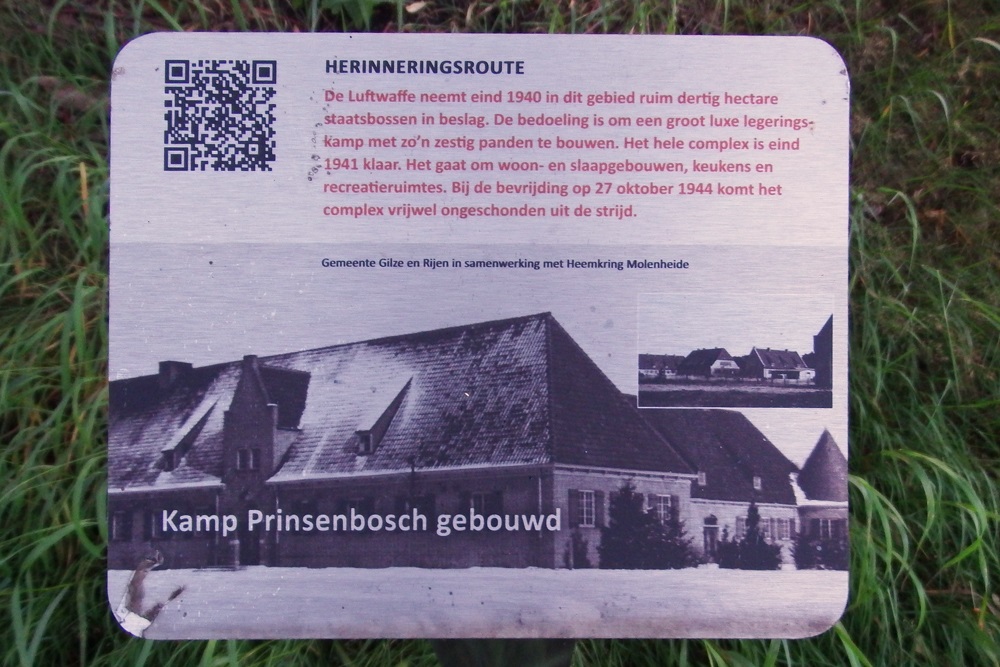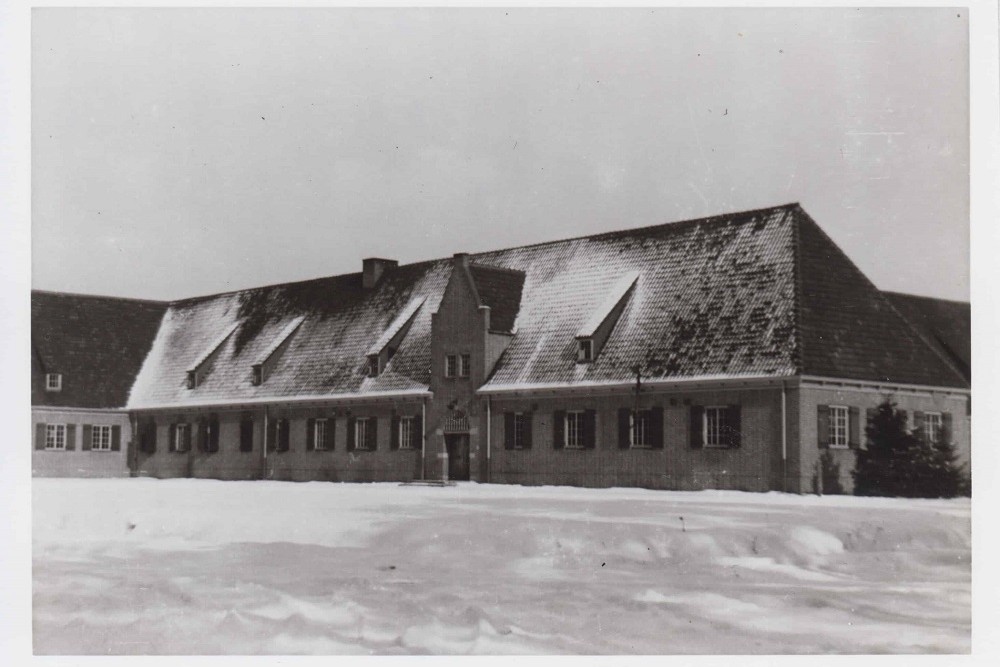Memory Route World War ll Camp Prinsenbosch Constructed
In the Municipality of Gilze and Rijen is a memory route created in memory of the Second World War.
In a number of places there is a sign with a description of what happened at that place in the Second World War.
CAMP PRINSENBOSCH CONSTRUCTED
In the autumn of 1940, some officers of the Luftgaukommando Holland visited the Prinsenbosch between Gilze and Chaam together with the forester. They orientated themselves extensively in the hundreds of hectares of forest area. They caught their eye in an area of more than thirty hectares. They did not say much about the plans that the Luftwaffe had with this piece of forest.
But in the spring of 1941 it became clear what intentions the Germans had with Prinsenbosch. They started preparations for an apparently very large construction project. Camp Prinsenbosch. They demarcated the outlines of some large and many smaller buildings. After clearing the trees, they dug out the cut pieces.
Dutch contractors and subcontractors carried out almost the entire construction project; residents of Gilze and the surrounding area found well-paid temporary work there. Despite the rapid progress, everything was performed remarkably solid and heavy. There was no doubt that this became a permanent building.
The destination of the buildings was also now becoming more apparent: residential and sleeping buildings for Luftwaffe staff. Firstly for aircrews. This could be deduced from the unusual luxury and the generous comfort with which the houses were furnished. The fact that the pilots and other crew members were pampered had to do with the heavy physical and psychological stress they had to work under.
The Germans built the camp in such a way that it looked like a friendly village from above. If an English pilot could find it and especially recognize it as a German encampment, there were the more than sixty centimeters thick walls made of Dutch brick and high windows with steel shutters. They offered reasonable protection against a dropped bomb. By using more than 15 cm thick concrete ceilings, the Germans were also prepared for phosphorus fire bombs. They could fall through the dull gray roof tiles, but the thick ceiling stopped the barb bombs, while the temperature downwards had little or no influence. In any case, residents had reasonable time to safely exit the building in the event of a fire.
The various roads that passed through the camp were given sounding names, indicated on artfully executed wooden signposts. For example, there was a Leipziger Strasse and a Frankfurter Allee. A man-sized fence was built around the entire complex. There were two permanently monitored entrances, one in the northwest corner at Hoogstraat and the other at Chaamseweg. Both had a guard building and a lockable gate. In addition, there was a telephone station at the entrance to Hoogstraat, which was connected to the airport with its own field telephone cable (thick rubber cable). This cable was broken in 1942, more than likely by sabotage.
We do not know whether the Germans still had a special name for Prinsenbosch and whether they ever officially opened the camp. Gilzen used to speak back then, and sometimes still speak about: "the villas in the Chaamse forests". Allied planes have never attacked the camp, if we can, and for good reason, consider the bomb strike at the northwest edge of the camp to be a fluke. That happened in the evening of February 26, 1943 around 10 p.m. One villa burned down by incendiary bombs and on 27 and 28 February 1943 a few more duds or time bombs exploded.
Anti-aircraft guns were not present in or near the camp, except for the battery-heavy Flak on the Bavelseweg at a mile away. But for English scouts it will have evoked more association with the airport than with the small, difficult to perceive and above all innocent looking Prinsenbosch.
During the hasty departure of the Luftwaffe on 4 and 5 September 1944, all buildings were left intact and without any form of security. They only set one smaller villa on fire; it contained a lot of rifle ammunition. The villa burned to the ground. The Luftwaffe never returned.
After the liberation, the English R.A.F. the camp in use; in 1946 the Dutch army. In 1953, it was temporarily used to shelter victims of the flood. From the end of 1993, the COA received asylum seekers there.
Do you have more information about this location? Inform us!
Source
- Text: TracesOfWar
- Photos: Peter van Hoek (1), Heemkring Molenheide (2)
- www.heemkringmolenheide.nl
Nearby
Point of interest
- Memory Route World War ll Verhoven Bombed - Verhoven
- Memory Route World War ll Hudson Bomber crashed at Warande in Gilze - Gilze (Gilze en Rijen)
- Memory Route World War ll V2 Fell in the Ridderstraat in Gilze - Gilze (Gilze en Rijen)
Monument
- Chapel Air Raid Shelter Gilze - Gilze (Gilze en Rijen)
- Liberation Route Marker 142: But this airfield brought disasters… - Gilze (Gilze en Rijen)
- Bell Seat - Liberation Memorial Roman Catholic Cemetery Gilze - Gilze (Gilze en Rijen)
Cemetery
- Collective Grave Civilian Casualties Roman Catholic Cemetery Gilze - Gilze (Gilze en Rijen)
- Commonwealth War Graves Roman Catholic Cemetery Gilze - Gilze (Gilze en Rijen)
- Graves Civilian Victims Catholic Cemetery Hulten - Hulten (Gilze en Rijen)
Remembrance Stone
Fortification
- Remnant Bunker Airport Gilze Rijen - Molenschot (Gilze en Rijen)
- Remnant Bunker Airport Gilze Rijen - Molenschot (Gilze en Rijen)
- Remnant Bunker Airport Gilze Rijen - Molenschot (Gilze en Rijen)






